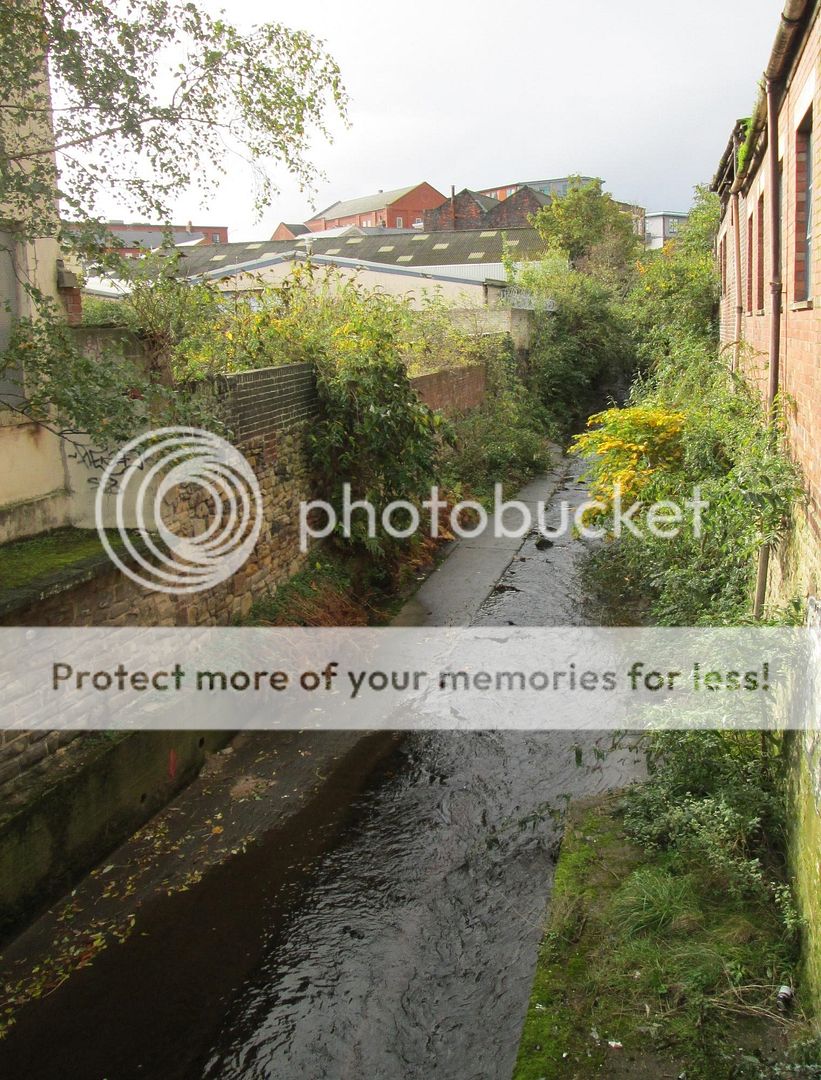- Joined
- Dec 2, 2005
- Messages
- 71,161
Part 1: http://www.bladeforums.com/forums/showthread.php/1229530-The-Dairy-Maids-of-Porter-Brook-(Part-1)
Part 2: http://www.bladeforums.com/forums/showthread.php/1231404-The-Dairy-Maids-of-Porter-Brook-(Part-2)

The blades they are sent to the wheel to be ground,
So we find the grinding trade goes the world round;
The rich grind the poor, and the great grind the small,
Thus we grind one another till death grinds us all.
(from The Cutlers Song, 18th century Sheffield ballad)




After Meadow Terrace, the River Porter flows on, running under Hickmott Road, between small terraced houses, and behind the oldest surviving cottages in the area (built by the Wilson family see below in 1810), which have now sadly been tarted-up beyond all recognition. After the river leaves Endcliffe Park, it gets increasingly difficult to follow, and since it is not possible to walk alongside the Porter at this point, it is necessary to take a parallel course, past the famous Two Steps fish n chip shop, and along Sharrow Vale Road. Soon, the next dam on the River Porter comes into view, sadly this beautiful mill-pond is the last of the Porter dams still in existence.

It is likely that Sharrow Wheel was already in existence by 1581, being known then as the Wheel at Sharrow Head, and owned by the Duke of Norfolk, with Thomas Greenwood as tenant. Greenwood was followed by a succession of tenants, and in 1737, Thomas Wilson, a shearsmith and edge tool maker, rented the wheel. Thomas had been Sheffields Master Cutler in 1731.
After Thomas Wilson died in 1740, his youngest son Joseph, took over the wheel. Joseph had trained as a silversmith, and had connections to Thomas Boulsover. He was also a plater and saw-maker, and he put all these skills to good use at Sharrow. However, it is as a snuff-maker that Joseph is remembered, and the business he founded is still running today. Joseph sounds to have been a bit of a character, and he wasnt very good with money by all accounts, being declared bankrupt in 1775, when he sold off all his interests apart from the snuff business. With help from relatives, Joseph managed to pay off his debts, and was released from bankruptcy in 1778.

Joseph was joined by two of his sons, Joseph Jnr and Thomas, and with their help, the snuff business prospered. In 1788 an agreement was drawn up giving full control of the business to Joseph Jnr and Thomas, along with their brother William, but family relations suffered, and Joseph later left his family and moved to London, where he set up house with a Mrs Deborah Andrews, a former employee. I dare say there are a lot of lines to be read between in that family scandal, and there was subsequent scandal when the old man, now married to the former Mrs Andrews, died, and a sum allegedly owed to him by his sons was not paid to his widow. The second Mrs Wilson lost the subsequent legal action.


In 1798, the former family home at nearby Highfield, (now a hotel and restaurant where I have dined), was sold to Joseph Ibberson, and the Wilsons moved to the mill (along with their other property, Westbrook House). In the following years the mill was extended, and by 1825 the dam and mill, now owned outright by the Wilsons, (along with a lot of other land in the area), had taken the form it exists in today. Over 250 years after it was founded, the business is still run by Joseph Wilsons direct descendants, and Wilsons snuff is popular the world over. The old water-wheel (with a diameter of nineteen feet and width of four feet eight inches) is still in working order and occasionally put into service.
While the view of Wilsons Snuff Mill has changed hardly at all since I was a boy, there have been changes to the area. The Piggy Jack Field where we played football has been covered with flats for a long time now, and the wall built to enclose them makes the ancient thoroughfare of Frog Walk (which the local students call Muggers Alley) a dark and gloomy place. The nearby stone wall which had a deep groove worn into it by generations of childrens feet has been surmounted by an ugly peak, and Frog Walk itself is litter-strewn and graffiti splattered.






Down in the ravine below Frog Walk, the River Porter flows on, passing under the once-grand entranceway to the old General Cemetery. Thousands of Sheffielders were once buried here, and when the city council decided to dig up most of the graves in the 1980s there was widespread controversy. Some of those against the scheme felt vindicated in their claims of divine opposition, when grass seed sewn by the council over the old plots began to sprout cabbages rather than grass!


Unfazed by the controversy, the River Porter continues to flow towards the centre of Sheffield. The footpath turns down Stalker Walk, named for the Stalker Wheel which once stood here (the weir for this wheel is still in existence just before the river flows under the entrance to the cemetery).
The Stalker Wheel can be traced back to at least 1606, when it was used for the grinding of knives and other edged tools, being leased from William Jessop of Broomhall by Thomas Philpott. The wheel remained in the ownership of Jessops heirs throughout the 18th century, still being used as a cutlery wheel.
By 1793, the wheel was tenanted by Joseph Ward, who employed fourteen men, working at ten trows.
In 1806, Joseph and William Wilson took over the lease. The water-wheel is described as thirteen feet in diameter and seven feet nine inches wide. The eleven trows were grinding edge tools and table knives, and were let out at £8 per annum. In 1818, Joseph bought the wheel, and by 1837-8, a new dam had been added.

During the mid 1800s, the wheel was owned and occupied by Henry Wilson, and it remained owned by the Wilsons until the 1870s, when the mill was no longer occupied. The Hardy Patent Pick Co used parts of the building between 1876 and 1884, but by the early 1890s both the dam and water-wheel had gone.







I would walk this way as a young child with my mother, going to and from my great grandmothers. Back then most of the route smelled like my fathers overalls, that unmistakeable aroma of industry, of old oil on hot machinery. The factories that lined the far-side of the Porter are gone now, demolished or effectively replaced. Across the way, you can still see Pomona Street School, as it used to be called, where my grandmother went as a child, before going to work with her mother at Chestermans Bow Works next door. The old Chestermans factory is now something to do with one of Sheffields universities.
Part 2: http://www.bladeforums.com/forums/showthread.php/1231404-The-Dairy-Maids-of-Porter-Brook-(Part-2)

The blades they are sent to the wheel to be ground,
So we find the grinding trade goes the world round;
The rich grind the poor, and the great grind the small,
Thus we grind one another till death grinds us all.
(from The Cutlers Song, 18th century Sheffield ballad)




After Meadow Terrace, the River Porter flows on, running under Hickmott Road, between small terraced houses, and behind the oldest surviving cottages in the area (built by the Wilson family see below in 1810), which have now sadly been tarted-up beyond all recognition. After the river leaves Endcliffe Park, it gets increasingly difficult to follow, and since it is not possible to walk alongside the Porter at this point, it is necessary to take a parallel course, past the famous Two Steps fish n chip shop, and along Sharrow Vale Road. Soon, the next dam on the River Porter comes into view, sadly this beautiful mill-pond is the last of the Porter dams still in existence.

It is likely that Sharrow Wheel was already in existence by 1581, being known then as the Wheel at Sharrow Head, and owned by the Duke of Norfolk, with Thomas Greenwood as tenant. Greenwood was followed by a succession of tenants, and in 1737, Thomas Wilson, a shearsmith and edge tool maker, rented the wheel. Thomas had been Sheffields Master Cutler in 1731.
After Thomas Wilson died in 1740, his youngest son Joseph, took over the wheel. Joseph had trained as a silversmith, and had connections to Thomas Boulsover. He was also a plater and saw-maker, and he put all these skills to good use at Sharrow. However, it is as a snuff-maker that Joseph is remembered, and the business he founded is still running today. Joseph sounds to have been a bit of a character, and he wasnt very good with money by all accounts, being declared bankrupt in 1775, when he sold off all his interests apart from the snuff business. With help from relatives, Joseph managed to pay off his debts, and was released from bankruptcy in 1778.

Joseph was joined by two of his sons, Joseph Jnr and Thomas, and with their help, the snuff business prospered. In 1788 an agreement was drawn up giving full control of the business to Joseph Jnr and Thomas, along with their brother William, but family relations suffered, and Joseph later left his family and moved to London, where he set up house with a Mrs Deborah Andrews, a former employee. I dare say there are a lot of lines to be read between in that family scandal, and there was subsequent scandal when the old man, now married to the former Mrs Andrews, died, and a sum allegedly owed to him by his sons was not paid to his widow. The second Mrs Wilson lost the subsequent legal action.


In 1798, the former family home at nearby Highfield, (now a hotel and restaurant where I have dined), was sold to Joseph Ibberson, and the Wilsons moved to the mill (along with their other property, Westbrook House). In the following years the mill was extended, and by 1825 the dam and mill, now owned outright by the Wilsons, (along with a lot of other land in the area), had taken the form it exists in today. Over 250 years after it was founded, the business is still run by Joseph Wilsons direct descendants, and Wilsons snuff is popular the world over. The old water-wheel (with a diameter of nineteen feet and width of four feet eight inches) is still in working order and occasionally put into service.
While the view of Wilsons Snuff Mill has changed hardly at all since I was a boy, there have been changes to the area. The Piggy Jack Field where we played football has been covered with flats for a long time now, and the wall built to enclose them makes the ancient thoroughfare of Frog Walk (which the local students call Muggers Alley) a dark and gloomy place. The nearby stone wall which had a deep groove worn into it by generations of childrens feet has been surmounted by an ugly peak, and Frog Walk itself is litter-strewn and graffiti splattered.






Down in the ravine below Frog Walk, the River Porter flows on, passing under the once-grand entranceway to the old General Cemetery. Thousands of Sheffielders were once buried here, and when the city council decided to dig up most of the graves in the 1980s there was widespread controversy. Some of those against the scheme felt vindicated in their claims of divine opposition, when grass seed sewn by the council over the old plots began to sprout cabbages rather than grass!


Unfazed by the controversy, the River Porter continues to flow towards the centre of Sheffield. The footpath turns down Stalker Walk, named for the Stalker Wheel which once stood here (the weir for this wheel is still in existence just before the river flows under the entrance to the cemetery).
The Stalker Wheel can be traced back to at least 1606, when it was used for the grinding of knives and other edged tools, being leased from William Jessop of Broomhall by Thomas Philpott. The wheel remained in the ownership of Jessops heirs throughout the 18th century, still being used as a cutlery wheel.
By 1793, the wheel was tenanted by Joseph Ward, who employed fourteen men, working at ten trows.
In 1806, Joseph and William Wilson took over the lease. The water-wheel is described as thirteen feet in diameter and seven feet nine inches wide. The eleven trows were grinding edge tools and table knives, and were let out at £8 per annum. In 1818, Joseph bought the wheel, and by 1837-8, a new dam had been added.

During the mid 1800s, the wheel was owned and occupied by Henry Wilson, and it remained owned by the Wilsons until the 1870s, when the mill was no longer occupied. The Hardy Patent Pick Co used parts of the building between 1876 and 1884, but by the early 1890s both the dam and water-wheel had gone.







I would walk this way as a young child with my mother, going to and from my great grandmothers. Back then most of the route smelled like my fathers overalls, that unmistakeable aroma of industry, of old oil on hot machinery. The factories that lined the far-side of the Porter are gone now, demolished or effectively replaced. Across the way, you can still see Pomona Street School, as it used to be called, where my grandmother went as a child, before going to work with her mother at Chestermans Bow Works next door. The old Chestermans factory is now something to do with one of Sheffields universities.
























